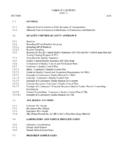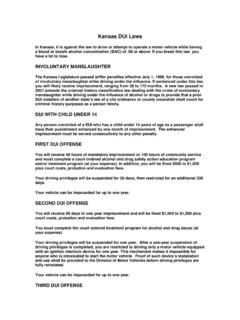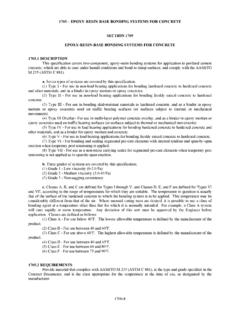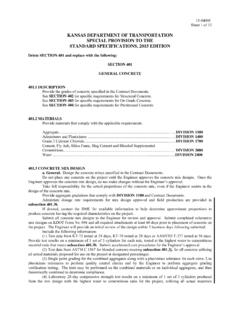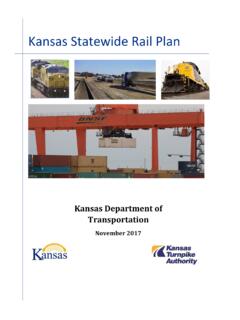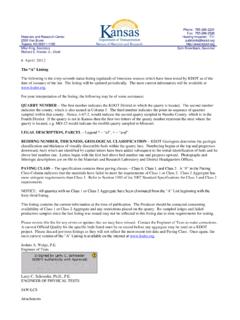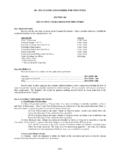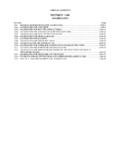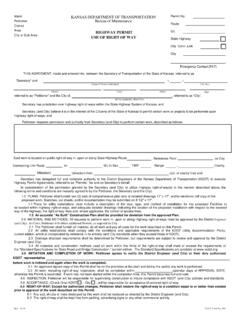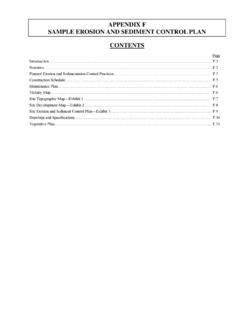Transcription of KDOT Erosion Control Manual 07 - Kansas …
1 KDOT TEMPORARY Erosion - Control Manual A Guide for the Design, Installation, Inspection, and Maintenance of Temporary Erosion - Control Measures in Kansas January 2007 PURPOSE & USE OF THE Manual PURPOSE Erosion Control is becoming an increasingly large part of highway design and construction. KDOT must comply with current federal and state Erosion - Control requirements and prepare to meet even more stringent requirements in the future. The development and implementation of an effective storm water pollution prevention plan (SWPPP) is essential. This Manual is intended to give designers, contractors, installers, and inspectors the tools they need to implement practical and efficient SWPPPs. Each chapter of this Manual includes sections on design, installation, inspection and maintenance for temporary Erosion - Control measures (TECMs).
2 Proper use of these devices will protect the environment while saving the user time and money. USE The format of this Manual facilitates its use. The TECM selection process has been streamlined through the use of flowcharts. The user identifies an Erosion or sedimentation condition (ditch, slope, and inlet) and then answers site-specific questions along the flowchart paths. When the end of a path is reached, TECM selection is complete. The user is then directed to specific pages in the Manual . Each TECM description contains information on design, placement, material specification, installation, inspection, and maintenance. No design calculations are needed all design data is in tabular form. If the user needs more information than is contained in this Manual , a list of additional Erosion - Control resources is included at the end of this Manual .
3 TABLE OF CONTENTS NPDES PERMITS .. 1 DESIGN OBJECTIVES .. 2 SELECTION TABLE .. 3 SECTION 1 Bale Ditch 4 SECTION 2 Silt-Fence Ditch 8 SECTION 3 Triangular Silt Dike Ditch 12 SECTION 4 Rock Ditch 15 SECTION 5 Bale Slope 18 SECTION 6 Silt-Fence Slope 21 SECTION 7 Bale Drop-Inlet 24 SECTION 8 Silt-Fence Drop-Inlet 27 SECTION 9 Triangular Silt Dike Drop-Inlet Barriers .. 31 SECTION 10 sediment 34 SECTION 11 Temporary Erosion - Control 38 SECTION 12 Temporary 39 ADDITIONAL RESOURCES .. 40 - 1 - NPDES PERMITS In an effort to limit the pollution of our nation s many streams, rivers, and lakes, the Environmental Protection Agency (EPA), directed by Congress, enacted Section 402 of the Clean Water Act, Section 402 established the National Pollutant Discharge Elimination System (NPDES) to regulate the discharge of pollutants from point sources.
4 In 1990, the EPA published further regulations under the NPDES program which defined the term storm water discharge associated with industrial activity to include storm water discharges from construction activities (clearing, grading, excavation, etc.) that disturb two or more hectares of total land area. The EPA granted the responsibility of administering and enforcing NPDES permitting to the states. In May of 1996, the EPA approved the Kansas Department of Health and Environment s (KDHE) NPDES Draft for Construction Activity permits in Kansas . An NPDES Permit authorizes a site owner to discharge storm water runoff. KDHE administers two types of NPDES permits: general and individual. To apply for a general permit, a site owner (in this case, the Kansas Department of Transportation) must file a Notice of Intent (NOI).
5 The NOI application requires basic information about the site s location, existing condition, future use, and storm water pollution Control measures. The general permit will apply to most projects. An individual permit is only required when certain pre-existing site conditions are encountered. These conditions concern proximity to one or more of the following: Indian Lands, contaminated soils, drinking water intakes, historical or archeological sites, and threatened or endangered species. Sites within one-half mile of a Critical Water Quality Management Area, Special Aquatic Life Use Waters, or an Outstanding Water Quality Management Area are also included. If any one of these site conditions is met, KDHE will investigate potential impacts and determine whether coverage under an individual permit is needed coverage under a general permit is still a possibility.
6 The core of the storm water permit process is the Storm Water Pollution Prevention Plan (SWPPP). An SWPPP is a listing of all planned Erosion and sediment Control practices on site. The SWPPP also addresses inspection and maintenance procedures. The SWPPP is not a required attachment to the NOI; however, it is necessary to have a copy of the SWPPP on site at all times. Currently, the KDOT Environmental Services Section files the NOI for most projects (with the exception of inter-local projects). In addition to the NOI, the general contractor must complete and sign the Contractor s Certification Form. By signing this form, the contractor signifies that he understands the terms and conditions of the NPDES General Permit. This form should be kept on site with the SWPPP. KDOT has developed a standard SWPPP for all its projects.
7 This SWPPP includes special provisions, standard drawings and specifications, inspection and maintenance report forms, the contractors site-specific Erosion - Control schedule, the KDOT Erosion - Control policy statement, and a memorandum for design and field engineers. Upon completion of the project and stabilization of the disturbed area, the owner files the Notice of Termination (NOT). A disturbed area is considered stabilized when vegetation has been established on 70% of the area. Filing the NOT signifies that coverage under the NPDES General permit is no longer needed. If further information is needed, consult the KDHE National Pollutant Discharge Elimination System Storm water Discharge Permit Information Packet. - 2 - DESIGN OBJECTIVES When developing a temporary Erosion - Control plan at your site, you should decide which of the following three design objectives is most feasible for your site: Keep the soil at its original location.
8 Keep the soil close to its original location. Keep the soil on site. Keeping the soil at its original location is the preferred objective. This option causes the least amount of harm to the environment. Not only does this option protect the surrounding land and water, but it also prevents costly regarding and redressing of slopes and ditches. However keeping the soil at its original location is not always feasible due to challenging topography and other site variables. If you can t keep the soil at its original location, at least try to keep it close. This option will require some regarding and redressing of slopes and ditches. Finally, if site conditions are such that neither of the first two objectives can be met, at least try to keep the soil from leaving the site. Soil transported off-site can cause far-reaching damage to the downstream environment.
9 Loss of soil from the site should be avoided to the extent practicable. - 3 - SELECTION TABLE The following table provides general guidance for the selection of the most appropriate temporary Erosion - Control measures. The table paths are generalized and do not represent every condition that may be encountered in the field. The selection of temporary Erosion - Control measures for some situations must be based on good judgment and past experience under similar conditions. Bale Ditch Checks (pg. 4) Silt-Fence Ditch Checks (pg. 8) Grade Less Than or Equal to 6%? TSD Ditch Checks (pg. 12) Rock Ditch Checks (pg. 15) Grade Greater Than 6%? Erosion - Control Blankets (pg. 33) Rock Ditch Checks (pg. 34) Ditches High Flows Expected? Erosion - Control Blankets (pg. 33) Temporary Seeding (pg. 34) Erosion Control ?
10 Erosion - Control Blankets (pg. 33) Bale Slope Barriers (pg. 18) Slopes sediment Control ? Silt-Fence Slope Barriers (pg. 21) Bale Drop-Inlet Barrier (pg. 24) Silt-Fence Drop-Inlet Barrier (pg. 27) Drop-Inlet Protection(No Decision Needed) TSD Drop-Inlet Barrier (pg. 30) sediment Basin > 10 acres sediment Basin (pg. 34) - 4 - SECTION 1 Bale Ditch Checks PURPOSE & OPERATION Bale ditch checks operate by intercepting and ponding sediment -laden runoff. Ponding the water reduces the velocity of the incoming flow and allows most of the suspended sediment to settle out. Water exits the check by flowing over the top. For ditches with steeper slopes and/or higher flows, an Erosion - Control blanket on the downstream side of the ditch check can serve as a scour apron that helps prevent more Erosion from this fl owing water.

